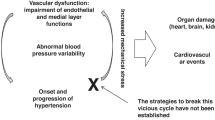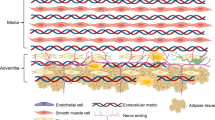Abstract
Macrovasculature, microvasculature and the heart determine the structure and function of the circulatory system. Due to the viscoelastic properties of large arteries, the pulsatile pressure and flow that result from intermittent ventricular ejection is smoothed out, so that microvasculature mediates the delivery of nutrients and oxygen to tissues steadily. The disruption of this function, which occurs when microvascular structure develops in response to hypertension, leads to end-organ damage. Microvascular structure is not only the site of vascular resistance, but also the origin of most of the wave reflections generating increased central systolic blood pressure (SBP) in the elderly. Nowadays many data of the literature suggest that hypertension-related damage to the micro and macrovascular system may be manageable through pharmacological agents. Among them, β-blocking agents and diuretics poorly modify microvascular structure, whereas angiotensin and calcium entry blockade has an opposite effect, thereby reducing central wave reflections and, finally, causing a selective SBP reduction.
This is a preview of subscription content, access via your institution
Access options
Subscribe to this journal
Receive 12 digital issues and online access to articles
$119.00 per year
only $9.92 per issue
Buy this article
- Purchase on Springer Link
- Instant access to full article PDF
Prices may be subject to local taxes which are calculated during checkout


Similar content being viewed by others
References
Safar ME, Levy BI, Struijker-Boudier H . Current perspectives on arterial stiffness and pulse pressure in hypertension and cardiovascular diseases. Circulation 2003; 107: 2864–2869.
Arterial stiffness in hypertension. In: Safar ME, O'Rourke HF (eds). Handbook of Hypertension, ol. 23 Elsevier Publishing: Edinburgh, 2006. pp 3–62, 75–136, 459–501.
Black HR . The paradigm has shifted to systolic blood pressure. Hypertension 1999; 34: 386–387.
Mulvany MJ, Aalkjaer C . Structure and function of small arteries. Physiol Rev 1990; 70: 921–971.
Lever AF . Slow pressor mechanisms in hypertension: a role for hypertrophy of resistance vessels? J Hypertens 1986; 4: 515–524.
Izzard AS, Heagerty AM, Leenen FH . The amplifier hypothesis: persisting dissent. J Hypertens 2002; 20: 375–377.
Mulvany MJ . Small artery remodeling and significance in the development of hypertension. News Physiol Sci 2002; 17: 105–109.
Schiffrin EL, Deng LY . Relationship between small-artery structure and systolic, diastolic and pulse pressure in essential hypertension. J Hypertens 1999; 17: 381–387.
Rizzoni D, Muiesan ML, Porteri E, Castellano M, Zulli R, Bettoni G et al. Effects of long-term antihypertensive treatment with lisinopril on resistance arteries in hypertensive patients with left ventricular hypertrophy. J Hypertens 1997; 15: 197–204.
Rizzoni D, Palombo C, Porteri E, Muiesan ML, Kozàkovà M, La Canna G et al. Relationships between coronary vasodilator capacity and small artery remodeling in hypertensive patients. J Hypertens 2003; 21: 625–632.
Rizzoni D, Porteri E, Boari GEM, De Ciuceis C, Sleiman I, Muiesan ML et al. Prognostic significance of small artery structure in hypertension. Circulation 2003; 108: 2230–2235.
De Ciuceis C, Porteri E, Rizzoni D, Rizzardi N, Paiardi S, Boari GEM et al. Structural alterations of subcutaneous small arteries may predict major cardiovascular events in hypertensive patients. Am J Hypertens 2007; 20: 846–852.
Mathiassen ON, Buus NH, Sihm I, Thybo NK, Morn B, Schroeder AP et al. Small artery structure is an independent predictor of cardiovascular events in essential hypertension. J Hypertens 2007; 25: 1021–1026.
Izzard AS, Rizzoni D, Agabiti-Rosei E, Heagerty AM . Small artery structure and hypertension: adaptive changes and target organ damage. J Hypertens 2005; 23: 247–250.
Rizzoni D, Porteri E, Platto C, Rizzardi N, De Ciuceis C, Boari GE et al. Morning rise of blood pressure and subcutaneous small resistance artery structure. J Hypertens 2007; 25: 1698–1703.
Agabiti Rosei E, Rizzoni D . The effects of hypertension on the structure of human resistance arteries. In: Lip GYH, Hall JE (eds). Comprehensive Hypertension. Elsevier: Mosby, 2007, Chapter 47, pp 579–590.
Schiffrin EL . Remodeling of resistance arteries in essential hypertension and effects of antihypertensive treatment. Am J Hypertens 2004; 17 (12 Pt. 1): 1192–1200.
Savoia C, Touyz RM, Endemann DH, Pu Q, Ko EA, De Ciuceis C et al. Angiotensin receptor blocker added to previous antihypertensive agents on arteries of diabetic hypertensive patients. Hypertension 2006; 48: 271–277.
Mathiassen ON, Buus NH, Larsen ML, Mulvany MJ, Christensen KL . Small artery structure adapts to vasodilatation rather than to blood pressure during antihypertensive treatment. J Hypertens 2007; 25: 1027–1034.
Savoia C, Touyz RM, Amiri F, Schiffrin EL . Selective mineralocorticoid receptor blocker eplerenone reduces resistance artery stiffness in hypertensive patients. Hypertension 2008; 51: 432–439.
Ting CT, Yang TM, Chen JW, Chang MS, Yin FC . Arterial hemodynamics in human hypertension. Effects of angiotensin converting enzyme inhibition. Hypertension 1993; 22: 839–846.
Chen CH, Ting CT, Lin SJ, Hsu FCP, Siu CO, Chou P et al. Different effects of fosinopril and atenolol on wave reflections in hypertension. Hypertension 1995; 25: 1034–1041.
Ting CT, Chen C-H, Chang M-S, Yin FCP . Short- and long-term effects of antihypertensive drugs on arterial reflections compliance and impedance. Hypertension 1995; 26: 524–530.
Mitchell GF, Vita JA, Larson MG, Parise H, Keyes MJ, Warner E et al. Cross-sectional relations of peripheral microvascular function, cardiovascular disease risk factors, and aortic stiffness: the Framingham Heart Study. Circulation 2005; 112: 3722–3728.
London GM, Asmar RG, O'Rourke MF, Safar ME, Reason Project Investigators. Mechanism(s) of selective systolic blood pressure reduction after a low-dose combination of perindopril/indapamide in hypertensive subjects: comparison with atenolol. J Am Coll Cardiol 2004; 43: 92–99.
Hirata K, Vlachopoulos C, Adji A, O'Rourke MF . Benefits from angiotensin-converting enzyme inhibitor ‘beyond blood pressure lowering’: beyond blood pressure or beyond the brachial artery? J Hypertens 2005; 23: 551–556.
Williams B, Lacy PS, Thorm SM, Cruickshank K, Stanton A, Collier D et al. Differential impact of blood pressure-lowering drugs on central aortic pressure and clinical outcomes: principal results of the Conduit Artery Function Evaluation (CAFÉ) study. Circulation 2006; 113: 1213–1225.
De Luca N, Asmar R, London GM, O'Rourke MF, Safar ME, TEASON Project Investigators. Selective reduction of cardiac mass and central blood pressure on low- dose combination perindopril/indapamide in hypertensive subjects. J Hypertens 2004; 22: 1623–1630.
Dhakam Z, Yasmin, MacEniery CM, Burton T, Brown MJ, Wilkinson IB . A comparison of atenolol and nebivolol in isolated systolic hypertension. J Hypertens 2008; 26: 351–356.
Acknowledgements
This review was prepared with the help of INSERM (Institut de la Santé et de la Recherche Médicale) and GPH-CV (Groupe de Pharmacologie et d'Hémodynamique Cardiovasculaire), Paris. We thank Dr Anne Safar for helpful and stimulating discussions.
Author information
Authors and Affiliations
Corresponding author
Additional information
Disclosures
None.
Rights and permissions
About this article
Cite this article
Safar, M., Rizzoni, D., Blacher, J. et al. Macro and microvasculature in hypertension: therapeutic aspects. J Hum Hypertens 22, 590–595 (2008). https://doi.org/10.1038/jhh.2008.43
Received:
Revised:
Accepted:
Published:
Issue Date:
DOI: https://doi.org/10.1038/jhh.2008.43
Keywords
This article is cited by
-
Critical Closing Pressure and Cerebrovascular Resistance Responses to Intracranial Pressure Variations in Neurocritical Patients
Neurocritical Care (2023)
-
A high normal ankle-brachial index is associated with biopsy-proven severe renal small artery intimal thickening and impaired renal function in chronic kidney disease
Hypertension Research (2020)
-
Vascular Aging and Central Aortic Blood Pressure: From Pathophysiology to Treatment
High Blood Pressure & Cardiovascular Prevention (2020)
-
Vascular Aging and Disease of the Small Vessels
High Blood Pressure & Cardiovascular Prevention (2019)
-
Relationships between blood pressure variability and indices of large artery stiffness: does the microvasculature play a role?
Hypertension Research (2017)



